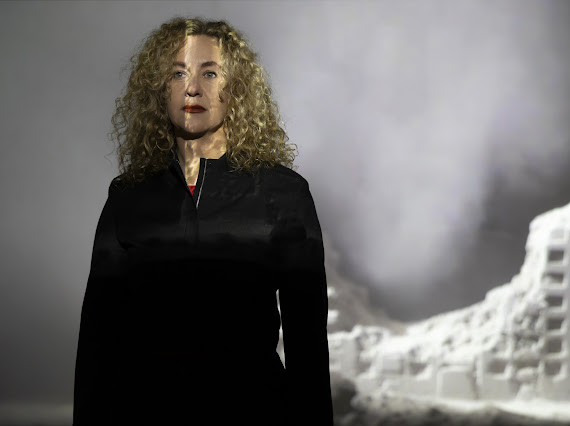The conversation featured Maria Mizina, curator of the project, and Mykhailo Alekseenko, a contemporary artist and author of the exhibition’s central installations. The discussion was moderated by journalist Kateryna Shyrokopoyas (Espresso TV).

“We cannot speak only of the past when tragedy is unfolding before our eyes,” said curator Maria Mizina. “For many of us on the team, Bakhmut is deeply personal. We know people who were captured or killed defending it. This is not just a city with a double tragedy — it’s part of our own lives.”
The exhibition merges archival materials from the Bakhmut Museum of Local History, photo documentation from the current war, and contemporary artworks to draw connections between atrocities committed by Nazi forces in 1942 and those perpetrated by the Russian military in the present day.
One of the focal works is Alekseenko’s audiovisual installation “Tears Shed”:
“It’s about the monotony of grief — the tears that fall every day and become routine,” the artist explained. “That steady drop is a metaphor for unending pain. But as viewers approach, they see their own reflection in the darkness. It’s about recognizing the self through the presence of others. Only the living can carry the memory of the dead.”

The speakers emphasized the importance of confronting history not only through fact but through emotional truth. The exhibition space — and the memory it enshrines — becomes a place where the weight of repetition can be felt viscerally.
“Our center is called ‘Living Memory’ for a reason,” Mizina added. “We are trying to reconstruct what the Soviet regime tried to erase. And Russia is attempting the same today. Most people don’t know Bakhmut’s history — it was suppressed. We want to bring it back, to help people understand why today’s violence is happening.”
Many of the archival photos — including from mass killings in mines near Bakhmut — overlap eerily with contemporary images from those same locations, now used by Russian forces.
“Where there was once a memorial — the Wailing Wall — there is now a weapons cache,” Mizina said. “This is not just painful. It’s a sign that history is being overwritten, again.”

The exhibition is intended for a wide audience, including young people. Alekseenko stressed the importance of trust and honesty when speaking to children about war and genocide:
“We shouldn’t underestimate children. Of course, sensitive content must be presented with care. But this is their history, too. Art helps reach those emotional depths that words cannot. Sometimes it even helps to heal.”
In closing, Mizina issued a stark warning:
“We made this exhibition to help people understand the nature of evil — how it reemerges. If we forget, if we stop naming what is wrong, if we compromise with evil, then what happened in 1942, in the 1970s, will happen again. Some believe peace can be made with tyrants. That was tried before — with Hitler. And it failed. Our message is clear: it will happen again and again, if we forget.”


📍 Exhibition Details
🗓 On view through the end of April
📌 Porokhova Vezha, 4 Pidvalna St., Lviv
🕛 Hours: Tue 12:00–18:00, Wed–Sun 12:00–20:00 | Closed Mondays
🎟 Admission: Free
This exhibition is presented by the Babyn Yar National Historical and Memorial Reserve in cooperation with the Center for Architecture, Design, and Urbanism “Porokhova Vezha”.
